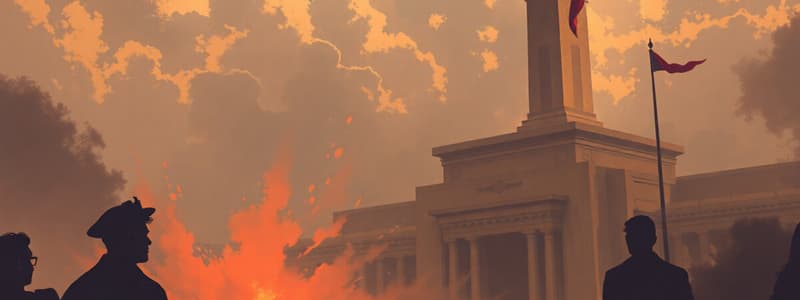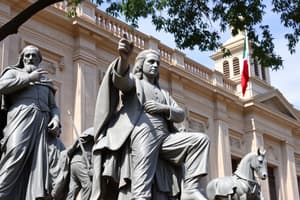Podcast
Questions and Answers
What was the president's primary goal in implementing the political reform?
What was the president's primary goal in implementing the political reform?
- To establish a more equitable system of government.
- To ensure civilian control over the military. (correct)
- To promote a more progressive social agenda.
- To establish a stronger military presence.
What was the impact of the president's political reform on the relationship between civilian and military power?
What was the impact of the president's political reform on the relationship between civilian and military power?
- It had no discernible impact on the power dynamics between the two groups.
- It led to an increase in military authority and power.
- It resulted in a more balanced and cooperative relationship between civilian and military institutions.
- It strengthened civilian authority and lessened the influence of the military. (correct)
Why might the president have chosen to implement political reforms while preparing for elections?
Why might the president have chosen to implement political reforms while preparing for elections?
- To distract from other political controversies and gain public favor.
- To demonstrate a commitment to democratic values and principles.
- To appease the military and ensure their support during the election.
- To increase his popularity among the civilian population and secure their votes. (correct)
What is the main theme of the content provided?
What is the main theme of the content provided?
Which of the following is NOT mentioned as a factor contributing to the president's decision for political reform?
Which of the following is NOT mentioned as a factor contributing to the president's decision for political reform?
What significant event does modern Mexican history begin with?
What significant event does modern Mexican history begin with?
What was one of the main goals of Juarez and the liberal cohort after their victory?
What was one of the main goals of Juarez and the liberal cohort after their victory?
How did Juarez's entrance into Mexico City in 1867 contrast with Maximilian's?
How did Juarez's entrance into Mexico City in 1867 contrast with Maximilian's?
What was the public's reaction to Juarez's return to Mexico City?
What was the public's reaction to Juarez's return to Mexico City?
What did Juarez do immediately after his triumphant return to Mexico City?
What did Juarez do immediately after his triumphant return to Mexico City?
Flashcards
The Restored Republic
The Restored Republic
The period following the defeat of Maximilian's empire in 1867, marked by the efforts to rebuild the Mexican republic and modernize its institutions and society.
Nascent Modernization
Nascent Modernization
The ideals of a modern nation-state, encompassing concepts like democratic governance, economic development, and social progress.
Constitution of 1857
Constitution of 1857
The 1857 Constitution served as a framework for liberal reforms, aiming to establish a democratic republic and promote individual freedoms.
Benito Juarez
Benito Juarez
Signup and view all the flashcards
Deeply Engrained Suspicion
Deeply Engrained Suspicion
Signup and view all the flashcards
Political Reform in Mexico
Political Reform in Mexico
Signup and view all the flashcards
Primacy of Civilian Rule
Primacy of Civilian Rule
Signup and view all the flashcards
Restored Republic
Restored Republic
Signup and view all the flashcards
Progressive Program
Progressive Program
Signup and view all the flashcards
Post-Revolutionary Political Changes
Post-Revolutionary Political Changes
Signup and view all the flashcards
Study Notes
The Restored Republic: Nascent Modernization
- Modern Mexican history begins with the liberal victory of 1867, marking the beginning of the republic.
- Juárez and his republican colleagues aimed to consolidate their victory by implementing the 1857 Constitution and modernizing Mexico.
- The Mexican political process showed signs of maturation, but scars remained from the Reform and intervention wars.
- Mexicans struggled with suspicion about differing opinions and ideologies, often leading to disputes.
- Juárez returned to Mexico City in 1867, in a simple black coach, in contrast to Maximilian's lavish entry in 1864.
- Juárez sought a third term in office, which was considered excessive by some.
- His first two terms were largely spent on the run.
- Juárez implemented important political and economic reforms.
Juárez's Third Term
- Juárez's return was triumphant, with significant public support.
- He recognized the need for consolidation and called for presidential elections, running for a third term.
- Some thought a third term was excessive given the previous administrations' challenges.
- Juárez reformed the country, tackling the deep-seated tension between factions.
- He reduced the size of the Mexican army from 60,000 to 20,000.
Economic and Educational Reforms
- Juárez appointed Matías Romero as Secretary of the Treasury, who devised a plan to revitalize the Mexican economy through improved transportation, the exploitation of natural resources, attracting foreign capital, and improving the mining industry.
- The plan emphasized reform of the tax and tariff systems.
- The new administration focused on revamping the economy, especially the mining industry, and improving educational foundations.
- Juarez created the Rurales to improve public security and order.
- The completion of the Mexico City-Veracruz railroad was a major economic development during the restoration.
Further details on the Restoration
- The railroad project faced engineering challenges and financial difficulties.
- The completion of the railroad project in 1872 greatly improved transportation and communication in Mexico.
- Juárez's new administration sought to further education and improve relations with foreign countries.
- Education improvements were focused on mathematics, natural sciences, and primary education.
- Primary education was made free and compulsory for the first time, with a significant expansion of schools.
- The development of the educational system aimed at providing more opportunities for all levels of society.
- Juárez made progress in mending relations with neighboring countries and other nations.
Division among Liberals
- Juárez's third term was highly contested, causing divisions within the liberal party itself.
- Notable competitors like Porfirio Díaz and Sebastián Lerdo de Tejada challenged his candidacy.
- The outcome of the election was controversial, and the political process remained volatile.
- The division among liberals and the death of Juárez ultimately paved the way for Porfirio Díaz's rise to power.
Lerdo's Presidency
- Lerdo, the new President, focused on establishing peace through firm executive control at both local and national levels. He intervened militarily in various situations.
- Lerdo continued some of the reforms initiated during Juárez's administration, including efforts to improve public infrastructure (such as railroads and telegraph lines.)
- Lerdo's administration was beset by political opposition and criticisms.
- A revolt, led by Díaz, challenged Lerdo's rule and eventually led to Díaz's victory, marking the end of an era of liberal governance.
Education during the Restoration
- Lerdo's administration continued improving education, boosting funds from both the federal and local levels to construct new schools.
- This period saw a general increase in construction to further expand primary schools, although enrollment growth was slower.
Studying That Suits You
Use AI to generate personalized quizzes and flashcards to suit your learning preferences.
Related Documents
Description
Explore the pivotal events of modern Mexican history, focusing on the restoration of the republic after Juárez's victory in 1867. Discover how Juárez and his colleagues implemented the 1857 Constitution and the political maturation of Mexico amidst ongoing disputes and reforms. This quiz delves into Juárez's leadership, his pursuit of a third term, and the impact of his policies.




